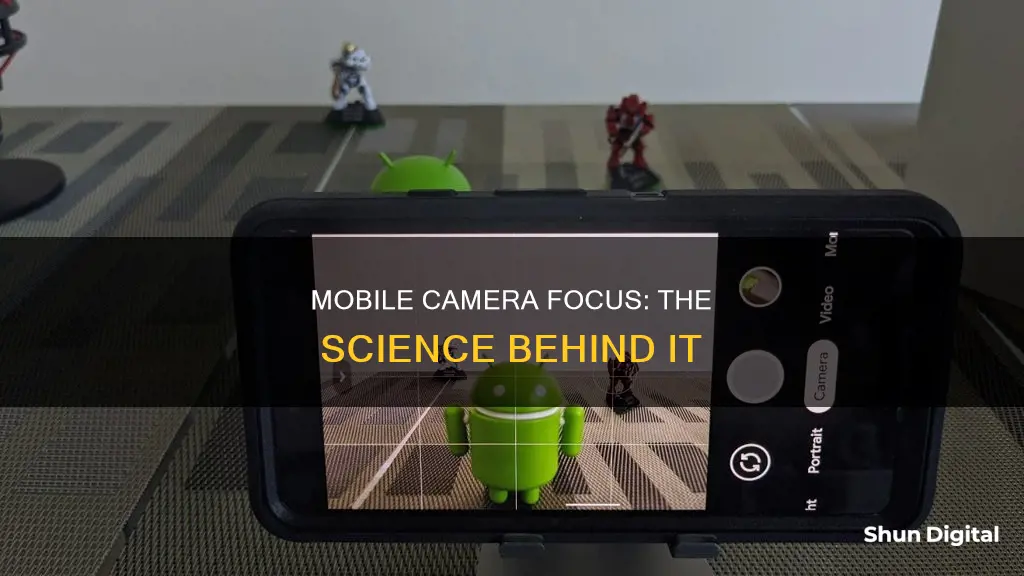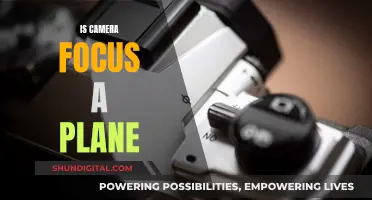
Getting the focus right is a big part of quality photography. Smartphone cameras have improved over time, and one aspect of this progress that is often overlooked is the autofocus system. The autofocus feature on smartphones allows them to automatically sharpen the image and focus on a specific spot or subject with minimal input from the user. There are three main autofocus methods: contrast-detection autofocus, phase-detection autofocus, and laser autofocus. Each method has its own advantages and disadvantages, and some smartphones even combine multiple methods to improve performance.
What You'll Learn
- Passive autofocus uses data from the image sensor to determine focus
- Active autofocus uses extra hardware to determine the distance from the phone to the target
- Phase-detection autofocus is a faster form of autofocus that ensures the same amount of light reaches two closely placed sensors
- Contrast-detection autofocus is the oldest and most popular method of autofocus, using the contrast between light and dark areas to bring the picture into focus
- Dual-pixel autofocus is a form of phase-detection autofocus that uses a far greater number of focus points across the entire sensor

Passive autofocus uses data from the image sensor to determine focus
Passive autofocus is a non-intrusive way for smartphone cameras to calculate and adjust their focus without the need for additional specialised hardware. It does this by relying on light and the contrast in the scene to ascertain focus. Passive autofocus uses data from the image sensor to determine whether the image is in focus and adjusts the lenses to compensate.
The common passive autofocus technique is based on detecting the contrast of the image and adjusting the focus until it's maximised. This method is entirely software-based, making it the cheapest option. However, it's slow and doesn't work as well in low-light conditions.
Passive autofocus can be achieved by phase detection or contrast measurement. Phase detection is achieved by dividing the incoming light into pairs of images and comparing them. Contrast measurement, on the other hand, is achieved by measuring contrast within a sensor field through the lens. The intensity difference between adjacent pixels of the sensor naturally increases with correct image focus. The optical system can then be adjusted until the maximal contrast is detected.
Passive autofocusing can be found in SLR devices, with the most common type being the autofocus "phase contrast" or "phase detection". This system is very effective in low light or low-contrast situations.
Charging the Fuji XT-30: A Quick Guide
You may want to see also

Active autofocus uses extra hardware to determine the distance from the phone to the target
Active autofocus systems use extra hardware to determine the distance from the phone to the target. The first active autofocus systems used sonar, similar to the Soli system on the Google Pixel 4. More recent active autofocus systems have added a low-powered infrared laser to estimate the distance to the target. This is calculated by measuring the time it takes for the laser to reach the object and bounce back to the sensor. This is known as the time-of-flight principle.
Infrared light is also used to triangulate the distance to the subject. This method was used in compact cameras such as the Nikon 35TiQD and 28TiQD, the Canon AF35M, and the Contax T2 and T3, as well as early video cameras.
Active autofocus systems can be tricked by other sources of infrared light, such as fires or other smartphones. They may also struggle with reflective surfaces and struggle to focus on objects very close to the camera. However, they can focus correctly even in total darkness.
The alternative to active autofocus is passive autofocus, which does not direct any energy towards the subject. Passive autofocus systems are dependent on a certain degree of illumination to the subject and can struggle in low-light conditions.
Converting ICC Profiles to Camera Raw: A Quick Guide
You may want to see also

Phase-detection autofocus is a faster form of autofocus that ensures the same amount of light reaches two closely placed sensors
Phase-detection autofocus (PDAF) is a faster form of autofocus that calculates the amount of light reaching two closely placed sensors. This technology is an evolution of the autofocus systems used in traditional cameras and DSLRs.
In PDAF, a small number of pixels on a sensor are set aside and embedded with a phase-detection photodiode, a device that converts light into an electric current. These pixels are scattered across the sensor, with some receiving light from the right side of the lens, and others from the left. This is similar to how humans receive light separately through their left and right eyes to create a single image in their brains.
The PDAF algorithm then determines if the image is in focus by comparing the data from the phase-detecting pixels. If the data from the light waves gathered from the photodiodes match, the light profile is in phase, and the picture is in focus. If not, the photodiodes' light information is used to determine how to adjust the lens to produce a sharp image.
PDAF is faster than other autofocus systems, such as contrast-detection autofocus (CDAF), because it uses algorithms and software to determine focus rather than mechanically adjusting the lens position. It is also more accurate than CDAF, especially when capturing moving subjects.
However, like CDAF, PDAF relies on light coming through the lens, so it may take longer to analyse and focus in low-light conditions. Additionally, the small size of smartphone sensors and pixels can make noise an issue in low-light situations. To compensate for these limitations, smartphones sometimes use a hybrid approach, combining PDAF with other autofocus methods.
Attaching Camera Battery Packs: Straps and Quick Tips
You may want to see also

Contrast-detection autofocus is the oldest and most popular method of autofocus, using the contrast between light and dark areas to bring the picture into focus
Contrast-detection autofocus is the oldest and most common method of autofocus, used in the majority of smartphones and compact cameras. It works by analysing the image on the sensor and measuring the contrast between light and dark areas. The lens moves back and forth in a stop-start manner, checking the contrast of the image after each movement. If the contrast increases, the lens is moving in the right direction; if it decreases, the lens moves the other way.
This process continues until the point of maximum contrast is found, which is when the image is in focus. This method is also known as 'trial and error'. It is a fairly cheap and easy system to implement as it doesn't require any additional hardware.
However, it is reasonably slow and can take around one second for the image to focus. This means that there is a chance the desired image will be missed, especially in fast-moving scenes. It also doesn't work well in low-light conditions or when tracking moving objects.
Evolution of Casio Cameras: First Screens Unveiled
You may want to see also

Dual-pixel autofocus is a form of phase-detection autofocus that uses a far greater number of focus points across the entire sensor
Phase-detection autofocus (PDAF) is a faster form of autofocus than the traditional contrast-detection autofocus (CDAF) method. It works by ensuring the same amount of light reaches two closely placed sensors on the photo sensor.
Dual-pixel autofocus (DPAF) is an extension of PDAF. It was introduced by Canon in 2013 with the EOS 70D camera and has since been featured in most new camera models released by the company. DPAF has also been adopted by smartphone camera manufacturers, first appearing in the Samsung Galaxy S7.
In DPAF, each pixel on the sensor is used for PDAF and aids in calculating phase differences and focus. Each pixel is split into two photodiodes, one left-looking and one right-looking. This allows each pixel to serve a dual role: capturing the image and providing focus data. This results in improved accuracy and speed compared to standard PDAF.
One of the main benefits of DPAF is improved low-light performance. By taking far more readings across the entire sensor, it smooths out noise for fast autofocus even in dark environments. DPAF also enables faster focusing speeds and a greater ability to maintain focus on fast-moving objects, making it ideal for capturing action shots.
Understanding Camera Raw Histogram: A Beginner's Guide
You may want to see also
Frequently asked questions
Autofocus (AF) is a feature that allows digital cameras and smartphones to automatically sharpen the image and focus on a specific spot or subject. This ensures that images are crisp and clear, with no blurring on the sensor and loss of detail.
Autofocus uses either a mechanical system or software to detect and adjust the focus. Mechanical systems involve moving lenses to vary the distance between the lens and the sensor. Software-based autofocus (passive autofocus) uses data from the image sensor to determine if the image is in focus and adjusts the lenses accordingly.
There are three main types of autofocus: contrast-detection autofocus (CDAF), phase-detection autofocus (PDAF), and laser autofocus. CDAF is the oldest and most common method, using the contrast between light and dark areas to bring the picture into focus. PDAF is a faster method that ensures the same amount of light reaches two sensors on the photo sensor. Laser autofocus, on the other hand, is an active autofocus system that uses infrared light to determine the distance to the object and adjust the focus.
Contrast-detection autofocus is fairly slow and may not work well in low-light conditions or when tracking moving objects. However, it doesn't require any additional hardware, making it a cheap and widely-used option.
Autofocus is usually sufficient for most situations and is quick and accurate. Manual focus is useful in low-light conditions or for artistic purposes and macro photography, as it allows full control over the focus.







